Nintendo’s gaming legacy has often been defined by stellar franchises, and few embody this sentiment more than Mario Kart. As the Switch 2 gears up for launch, all eyes are on Mario Kart 9, anticipated to be its flagship title. Yet, this highly-favored racer carries an immense burden: how to outshine the monumental success of Mario Kart 8 Deluxe. With over 67 million units sold, and often underestimated as merely a port from the Wii U, Mario Kart 8 has become a touchstone for casual gamers and die-hard fans alike. The question looms large: can Mario Kart 9 drive enough interest to create a compelling case for the new hardware?
The Marketing Challenge Ahead
Recent discussions among former Nintendo employees Kit and Krysta have illuminated the uphill battle facing Mario Kart 9. They articulated a crucial point: a substantial portion of the gaming populace already indulges in Mario Kart 8. For many of these players, the prospect of upgrading to a new console—especially in an era where budgets are tighter—might seem untenable. Their analysis underscores a stark reality: while Mario Kart 9 is poised to be an incredible game showcasing new features and capabilities, it may not automatically resonate with those who already have the robust experience of its predecessor.
Kit summarized this conundrum succinctly, expressing skepticism about whether parents would be ready to invest in another console just to access a new iteration of a familiar game. It raises an essential question about value perception within the gaming community. Historically, console launch titles have tended to be groundbreaking, either by showcasing unique gameplay mechanics or by significantly elevating the gaming experience. As Nintendo attempts to carve out a niche for the Switch 2, Mario Kart 9 must offer an irresistible draw to spur sales.
The Legacy of Mario Kart 8 Deluxe
Mario Kart 8 Deluxe isn’t merely a success story; it’s a cultural phenomenon that has shaped multiplayer gaming. It has become a staple at social gatherings, family events, and gaming marathons. By consistently rolling out content updates, Nintendo has kept the excitement alive, ensuring that the experience remains fresh and engaging. This kind of continual support can lead to a sense of attachment, creating a community around it that is reluctant to abandon what feels like a well-loved family member.
To overcome this emotional connection, Mario Kart 9 needs to leverage not just nostalgia but also innovation. Whether this involves introducing new characters, unique track designs, or game-changing mechanics, the next edition must offer something that feels more than just an iteration; it must feel revolutionary.
Nintendo’s Strategy for a New Generation
The gaming landscape is markedly different than it was when the Switch made its debut. Console exclusivity, online connectivity, and player engagement are pivotal in swaying consumers. The Legend of Zelda: Breath of the Wild launched the Switch 2’s predecessor with then-unprecedented acclaim, setting a high benchmark. Nintendo learned the hard way from its Wii U era that reliance on familiarity alone may not yield a winning strategy.
Anticipating this, Nintendo appears determined to ensure that Mario Kart 9 will not only serve as a nostalgic bridge for returning players but also attract newcomers. This could be an opportunity for the company to redefine competitive racing games with enhanced online features or augmented reality integrations that engage players more deeply than ever before. Engaging content that captures the imagination of younger players could mean the difference between a one-time purchase and sustained interest.
The Countdown Begins: Expectations vs. Reality
As fans gear up for what they hope will be a groundbreaking addition to the Mario Kart legacy, the anticipation is layered. Some are ready to jump in on day one, believing that Nintendo’s return to form will result in a must-have experience. Others, however, might play the waiting game, looking for traction from initial reviews or insights on differently themed games that may emerge over the months following the Switch 2’s launch.
In an era where gaming experiences are constantly evolving, would Mario Kart 9 emerge distinctly enough to win over skeptics and long-standing fans? The next few months will prove critical as Nintendo attempts to navigate this delicate balance, poised at the intersection of nostalgia, innovation, and consumer expectation. With the gaming world watching closely, the stakes have never been higher for both the company and its passionate community.

